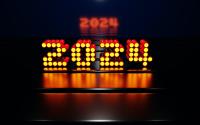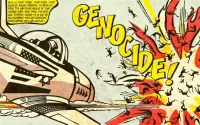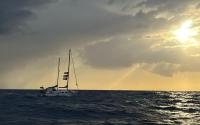November 3, 2002A little way off the Californian coast, near the island of San Clemente, the men of the USS Constellation's squadrons were last week going through their paces to ready themselves for war.
For the past two weeks the pilots of the 41-year-old carrier's Tomcat and Hornet squadrons - units nicknamed the Bounty Hunters, Vigilantes and Death Rattlers - have been training up for the Constellation's last exercise before setting sail this weekend for the Gulf and, what many of the ship's crew believe, is the certainty of war with Iraq.
It is a message reinforced by a new mural that has been painted by the flight crews inside the carrier's packed hangar deck - a mural depicting the American flag, an eagle and the motto 'Terrorist Elimination Unit'.
At the end of the three weeks or so it will take to sail to the Gulf, the Constellation will join its battle group, part of the largest build-up of US warships in the region since the Gulf war of 1991.
There the Constellation - due to be scrapped next year - will be joined by its sister ship the USS Nimitz, which is due to arrive in the region in late December or early January, and the USS Harry S. Truman which is due to sail with its battle group also in December. Last week it was the turn of the USS Kitty Hawk and its ships, stationed in Japan and the only carrier group not permanently based in the US, to slip out of its port and head for the Gulf.
It is not just the American carrier groups that are setting sail for a new war. Also last week 2,200 men of the 24th Marine Expeditionary Unit passed through the Suez Canal on three ships, joining two Apache helicopter squadrons from the US army's Germany-based V Corps which were moved to Kuwait last month.
Several thousand US Marines from Camp Pendleton, also in California, have already set out for the Gulf region with their amphibious battle group formed up around the USS Belleau Woods amphibious ready group (ARG), while thousands more from the same base are preparing to join them when their own amphibious group led by the USS Tarawa sets sail in the next few months.
But if the deployments over the past weeks and months have been piecemeal and discreet, they have been no less massive for it.
Indeed, already, say analysts, some 40,000 to 50,000 US servicemen and women are converging on the Gulf.
In another sign of the advanced state of preparations for a war early next year the Pentagon has also turned its mind to how the conflict will be reported, offering basic military training to the US journalists who will accompany US combat units.
The frenetic pace of military preparations in the US and the UK are in stark contrast to the haggling at the UN Security Council in its deliberations over the wording of a new resolution to force Iraq to comply with weapons inspections.
France, Russia and China may still be arguing that the UN will need to meet again to green light any military action against Iraq should Saddam Hussein again defy UN weapons inspectors, but in the armed forces of the US and Britain the assumption is that there will be a war against him early next year.
As more details of the military preparations have emerged on both sides of the Atlantic, what has also become apparent is that President Bush and his closest ally Tony Blair have been working to a tight timetable for military action that not even the long-winded deliberations of the UN Security Council have derailed.
In Britain, at least, the only casualty of the delays at the UN has been a cosmetic one. Originally, say well-informed sources, the Ministry of Defence had planned to announce which troops and armour Britain would be sending to the Gulf during Defence Questions in the House of Commons last week, an announcement that has been put off.
What has not been delayed, however, has been the political spade work by Number 10 to persuade key members of the Parliamentary Labour Party of the necessity of the coming war.
For the past three weeks, the Prime Minister has been quietly inviting small groups of carefully selected backbenchers - those with reasonably argued, often private objections to the war, many of them newer MPs, rather than the anti-war campaigners who have dominated the airwaves - to Downing Street for discussions about Iraq.
The Government's obligations under international law, the importance of a UN resolution, and the exact nature of Downing Street's ability to influence US decision-making have all been raised.
Little if anything has been given away about his intentions: Blair has been in 'listening mode', according to MPs, apparently trying to work out what will be necessary to win over the silent majority of the Labour Party which has concerns about war but could be persuaded it is necessary. There are signs his tactics may be paying off.
'I hate to admit it, but I did come out thinking, well, maybe they have been playing a cleverer game with Bush than we all thought,' says one senior woman MP.
The deployment of the USS Constellation yesterday has coincided with the most overt declaration by senior US military figures that they are now ready for war against Iraq.
Last week US Army Secretary Thomas E. White declared his forces ready for war in the cities of Iraq, if urban combat becomes necessary. In a meeting with reporters, White stated bluntly: 'I'll just say the Army's ready. That's our job, to be ready. And the army's ready.'
What they are getting ready for was revealed last week by Captain Glenn Kozelka of the US Army's 10th Mountain Division at Fort Polk, Louisiana, in an interview with the Washington Post .
Seven months ago, Kozelka and his men were hunting al-Qaeda in the mountains of Afghanistan; now they are training for the battle for Baghdad at the US military's most sophisticated urban warfare training centre, amid unsettling assessments by American military planners that any heavy fighting in the streets of the cities of Iraq could lead to US casualties of up to 30 per cent.
'We call it three-dimensional warfare,' Kozelka told the paper last week during his training. 'You can be shot from all around.'
For all the preparations for street to street fighting, it is not a strategy that the Pentagon intends to get sucked into.
Instead say analysts, Pentagon strategists favour cordoning off Baghdad, providing escape routes for civilians and surrendering military personnel, and striking critical facilities whose loss, over time, should make the city, and Saddam's government fall.
It is not justthe US army and navy that is preparing for a new Gulf war. In further signs that Bush and his British allies are accelerating towards an almost inevitable conflict, the Bob Hope and the Fisher - both large military cargo ships capable of carrying helicopters and heavy armour - have been ordered to begin loading military equipment at an undisclosed location on the US East Coast.
Sources aboard vessels of the Ready Reserve Force - cargo ships maintained by the US government - have also said that they are in the process of being outfitted with chemical, biological and radiological defensive gear, including gas masks, protective suits and hazard-detection devices. Some ships, say the same reports, have had their weapons lockers - empty in peacetime - stocked with small arms and ammunition.
And at the epicentre of the military build-up is Qatar's Al Udeid air base.
Last week, in another indication that the countdown to a war against Saddam has already begun in earnest, General Tommy Franks, the head of US central command, announced that he would be moving his headquarters in December from Tampa, Florida, to Al Udeid, his new forward command headquarters for a war against Iraq.
In Al Udeid the preparations for war have been in train for 12 months, since the Pentagon began pouring additional personnel and funding into the base last November in hopes of using it as an alternative to Saudi bases in the event of military action.
The base, which has one of the longest runways in the Middle East, is currently home to roughly 3,000 US per sonnel and 50 aircraft, including fighters, bombers and reconnaissance and refuelling aircraft.
According to defence sources and independent analysts, all the evidence points to US forces being readied for war by mid-December at the latest.
'There are a lot of very active preparations for war under way,' said one defence official. 'Everything is being moved rapidly into place so that the US and its allies can strike almost immediately should Bush decide that time has run out for the UN and its inspectors.'
It is at that point that the final deployments are likely to be made. The clearest signal that the world is only weeks from war will be apparent at the remote air force bases in the American Midwest and Southwest, where the country's radar-evading stealth aircraft are kept, as well as at a sleepy army town in southern Kentucky, home to elite helicopter-borne troops.
Another unmistakable sign of impending war will be the call-up of National Guard and Reserve forces by Bush, probably at least a month before he authorises a strike - the tens of thousands of part-time soldiers needed, from pilots and engineers to air traffic controllers and military policemen.
By then if Saddam is thinking that the time has finally come to blink and back down to the UN and avert a war that will remove him - it will be too late.






